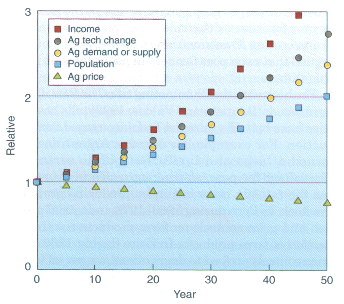
If the demand for farm produce X has an income elasticity of d and a price P elasticity of e, then
And if the supply elasticity of the farm produce is k,
The equations can be simplified by setting the initial values N(0), Y(0), B(0), and X
Draconian rules against expanding cultivation, consequently dear food, and thus intensive farming could spare more land for Nature. As mobs have taught rulers of Rome, revolutionary France, and modern states, however, costly bread incites riots.
Governments have set aside farm land to support prices only when their other programs and farmers have produced abundance. So I must ask how high food prices would rise if ten billion people demanded food while cropland was held constant to spare the present area for Nature. William Nordhaus showed me the following broad view, and I incorporate it here.
Let population N grow with time t at a relative rate
of n. Let income Y(t) grow with the number of people
and an overall technological change that proceeds at
a relative rate g. Let technological change B(t) in
agriculture proceed at a rate h different from the rate
g of overall technological change.

If the demand for farm produce X has an income elasticity
of d and a price P elasticity of e, then
![]()
And if the supply elasticity of the farm produce is k,
![]()
The equations can be simplified by setting the initial
values N(0), Y(0), B(0), and X![]() each equal to 1.
each equal to 1.
The last two equations, those for X, give the price as
![]()
That is, the price at time t will be set by income, which
is determined by population and overall technological change.
Agricultural technological change, income
elasticity of demand, and demand and supply elasticities
of price also will affect price.
 Figure 8.4.1. A scenario of rising population, income, and
demand; agricultural technological change; and
falling prices.
Figure 8.4.1. A scenario of rising population, income, and
demand; agricultural technological change; and
falling prices.
Figure 8.4.1 demonstrates the outcome of the scheme for the values n = 0.014, g = 0.01, h = 0.01, d = e = k = 0.6. These values are reasonable. Experts expect population to grow annually by 1.6% until 2000 AD. and then slow to 1.0% by 2020 (United Nations, 1991[UN:91], 22). The sum of g and h exceeds most recent and projected increases in U.S. yield of crops and feed in Table 8.2.2 and recent improvement of U.S. land productivity in Table 8.2.1. On the other hand, the sum of g and h equals the annual 2% rise of global maize yields in Figure 8.2.1 and the improvement in U.S. land productivity from 1950-1979 shown in Table 8.2.1. Taken together, the parameters produce an annual decline of food prices of 0.5%, which matches the 1900-1984 fall of world prices of main agricultural products (Binswanger et al., 1985[BMYB85]).
The h for agricultural technological change could cloak an expansion of cropland in addition to rising yields per plot. Expansion caused some of the rise of grain production in Figure 8.1.2. But sparing land for Nature rather than expanding tillage is the goal. If land is to be spared, g and h must represent increases in yield. Obviously, only rises in yield causing the sum of g and h to be 1 to 2%/yr can feed at reasonable prices a population rising at 1 to 2%/yr while sparing land for Nature.
Although my title concentrates on land for Nature, the full challenge for agriculture encompasses sparing land and keeping food affordable. If food becomes steadily dearer, hope for sparing land will flicker out. Taking Nordhaus' broad view and confining agricultural technological change to rising yield per plot, that is, omitting expanded cultivation, I can envision a future that spares both land and riots.